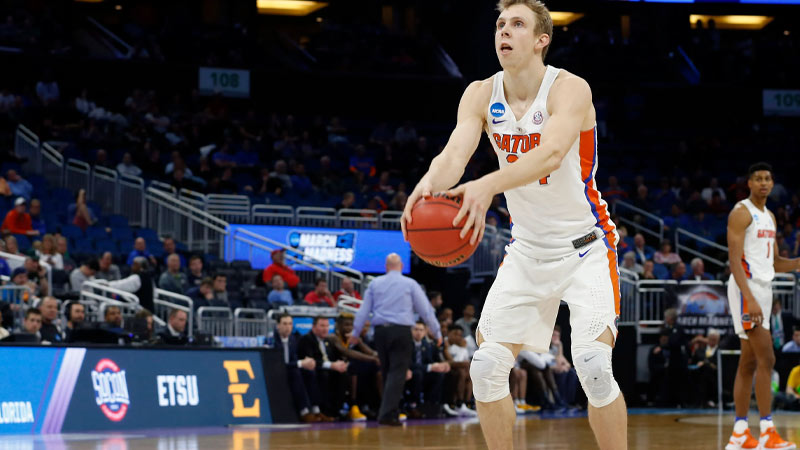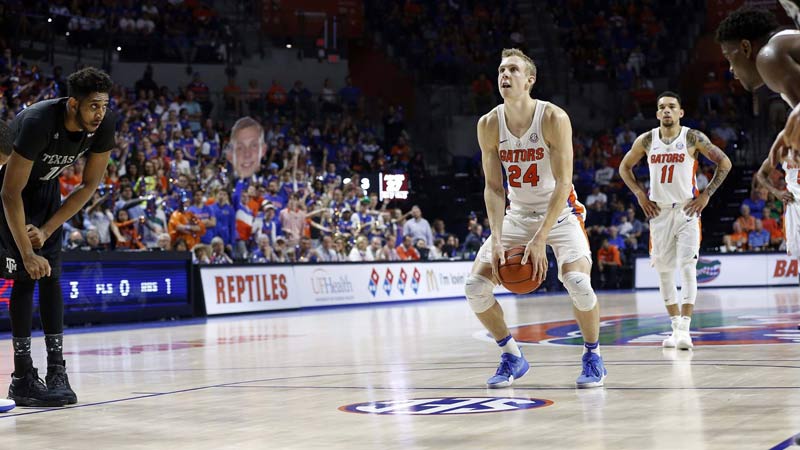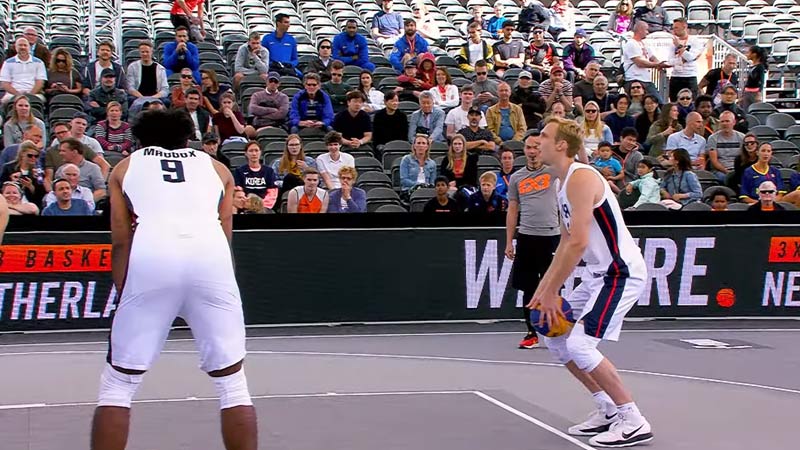In the realm of basketball, shooting free throws is a crucial skill that can make or break a player’s performance.
While the traditional overhand shooting technique has long been the norm, a curious question arises: Why don’t more basketball players take free throws underhanded?
This blog post explores the factors behind the limited adoption of the underhanded or granny shot technique in free throw shooting and delves into the perceptions, stigmas, and practical considerations that contribute to its rarity.
What Does Taking Free Throws Underhanded Mean?
Taking free throws underhanded refers to shooting free throws in basketball using an underhanded or granny shot technique.
Instead of the traditional overhand shooting motion, where the ball is released from above the head, players utilizing the underhanded technique shoot the ball with an underhand tossing motion, often resembling a pendulum-like swing.
To take a free throw underhanded, the player typically bends their knees, brings the ball down between their legs, and then propels it upward towards the basket using an underhand motion.
The shooting hand follows through toward the target, while the other hand provides balance and support. The shot is often characterized by a high arc and backspin, which can increase the chances of the ball dropping into the basket.
The underhanded free throw technique gained notable attention throughout the career of NBA legend Rick Barry.
Barry achieved remarkable success and accuracy at the free-throw line by shooting underhanded, prompting discussions about the effectiveness of this alternative shooting style.
While shooting free throws underhanded is not commonly seen in professional basketball today, some players have experimented with the technique.
Advocates of the underhanded free throw argue that it can offer advantages such as improved accuracy, consistency, and reduced interference from the arm and wrist.
The high arc and backspin of the shot can also increase the margin for error and improve the chances of the ball going through the hoop.
Rick Berry’s Basketball Underhanded Free Throw

Source: desmoinesregister.com
Rick Barry, a former NBA player, became renowned for his distinctive underhanded free-throw technique. Barry’s shooting style, often referred to as the “Granny Shot,” deviated from the traditional overhand form, as he opted to shoot the ball underhanded with both hands.
Despite its unconventional appearance, Barry’s underhand free throw proved to be highly effective throughout his career.
Barry’s decision to shoot underhanded was driven by a desire for accuracy. He recognized that shooting underhanded allowed for a more consistent release and spin on the ball, leading to improved shooting percentages.
His approach paid off, as he retired with a remarkable career free throw shooting percentage of over 89%. This success from the free-throw line played a significant role in Barry’s overall scoring prowess.
Despite the effectiveness of the underhand technique, it did not gain widespread acceptance in the basketball world. Many players hesitated to adopt the style due to concerns about its aesthetics and potential impact on their reputation.
The underhanded free throw remained largely associated with Barry, who stood out as a unique and successful practitioner of this shooting method.
Rick Barry’s underhanded free throw technique has become a part of basketball lore. His ability to achieve consistent accuracy with the Granny Shot serves as a testament to the importance of finding unconventional but effective methods within the game.
What is Granny Shot?
The “Granny Shot” is a term used to describe a shooting technique in basketball where a player shoots the ball underhanded, often with an exaggerated, pendulum-like motion.
The name “Granny Shot” stems from the imagery of an elderly person shooting a basketball in a similar manner.
The Granny Shot, also known as an underhand free throw, is an unconventional shooting technique in basketball. It involves tossing the ball underhanded with both hands in a swinging motion.
The term originates from its resemblance to the way a grandmother might shoot a ball. While rarely used in competitive basketball, Rick Barry popularized the technique during his successful NBA career.
Shooting underhanded can offer better accuracy, as evidenced by Barry’s impressive free-throw shooting percentage.
However, the Granny Shot has not gained widespread acceptance due to its perceived lack of style and masculinity. Most players opt for traditional shooting forms, making the Granny Shot a rare sight in modern basketball.
Why Don’t More Basketball Players Take Free Throws Underhanded

Source: roundballdaily.com
The underhanded or granny shot technique for shooting free throws in basketball is not widely adopted by players, despite its potential advantages. Several factors contribute to the limited use of this technique:
Perceived Image
Shooting free throws underhanded is often associated with a lack of aesthetics and can be seen as less “cool” or less fitting within the modern game.
Players, especially at the professional level, may prioritize a shooting style that aligns with conventional norms and is considered more visually appealing.
Social Stigma
The underhanded technique has acquired a certain stigma over time, with negative connotations attached to it.
Players may be hesitant to deviate from the traditional overhand shooting form due to fear of being ridiculed or judged by their peers, coaches, or fans.
Established Shooting Form
Many basketball players spend years developing their shooting mechanics using the overhand technique. They become comfortable and confident with their shooting form, making it challenging to switch to a completely different style, such as the underhanded free throw.
The muscle memory and repetition built around the overhand shot can make it difficult to adapt to a new technique.
Lack of Familiarity
The underhanded technique requires relearning shooting mechanics and adjusting to the different release points, timing, and trajectory compared to the overhand shot.
It takes time and practice to become proficient and consistent with the underhanded free throw, which may discourage players from adopting the technique.
External Pressure
Basketball players, especially those in high-pressure situations like professional games, may feel additional pressure to conform to conventional shooting methods.
The expectation to perform at a high level and meet certain standards may dissuade players from experimenting with alternative techniques like the underhanded free throw.
While some players have successfully used the underhanded technique, such as Rick Barry who shot exceptionally well from the free-throw line, the combination of social, psychological, and practical factors has limited its widespread adoption.
Ultimately, players tend to stick with shooting forms they are comfortable with and that have proven effective for them, even if alternative techniques may offer certain advantages.
FAQs
Isn’t shooting underhanded more accurate?
Yes, shooting underhanded can offer potential advantages in terms of accuracy. The underhanded technique allows for a higher arc and backspin on the ball, increasing the margin for error and improving the chances of the ball dropping into the basket.
NBA legend Rick Barry notably achieved remarkable success at the free-throw line with his underhanded technique, boasting one of the highest free-throw percentages in history.
However, despite the potential for improved accuracy, many players opt for the traditional overhand shooting form due to various reasons.
Why is there a stigma associated with the underhanded technique?
The underhanded free throw has acquired a negative stigma over time, often being perceived as less aesthetically pleasing or “cool.” Players may face ridicule or judgment from peers, coaches, or fans if they deviate from the traditional shooting form.
The social pressure to conform to the established norms and maintain a certain image can discourage players from experimenting with alternative techniques.
Are players hesitant to switch due to the unfamiliarity of the underhanded technique?
Yes, the underhanded technique requires a significant adjustment in shooting mechanics compared to the overhand shot. Players who have spent years developing their shooting form and building muscle memory may find it challenging to switch to a completely different style.
The unfamiliarity of the underhanded technique, including the release point, timing, and trajectory, can be a deterrent for players who are already comfortable and confident with their current shooting form.
Do players face external pressure to adhere to conventional shooting methods?
Absolutely. In high-pressure situations like professional games, players may feel external pressure to conform to the traditional shooting style.
The expectation to perform at a high level and meet certain standards can discourage players from deviating from the established norms. Coaches, teammates, and fans often reinforce these expectations, making it harder for players to explore alternative techniques like the underhanded free throw.
Have any players successfully used the underhanded technique?
Yes, there have been successful cases. Rick Barry, as mentioned earlier, achieved remarkable accuracy with his underhanded free throws. His success serves as a testament to the effectiveness of the technique.
Additionally, other players like his sons, Jon, and Brent Barry, have experimented with the underhanded style during their careers and achieved respectable free-throw percentages. These examples highlight that the underhanded technique can indeed be effective, even if it hasn’t gained widespread adoption.
Wrapping Up
While shooting free throws underhanded offers potential advantages in terms of accuracy and consistency, it remains a rarity in basketball. The negative stigma, perceived lack of aesthetics, and the challenges of adapting to a new shooting technique are key factors behind the limited adoption.
The pressure to conform to conventional norms and the comfort players find in their established shooting forms further contribute to the rarity of the underhanded free throw.
However, notable success stories like Rick Barry remind us that alternative techniques can be effective, prompting further exploration and discussion in the realm of free throw shooting. Have a nice day.







